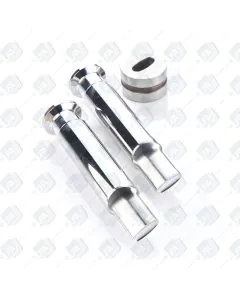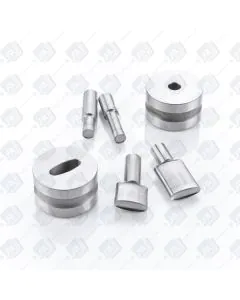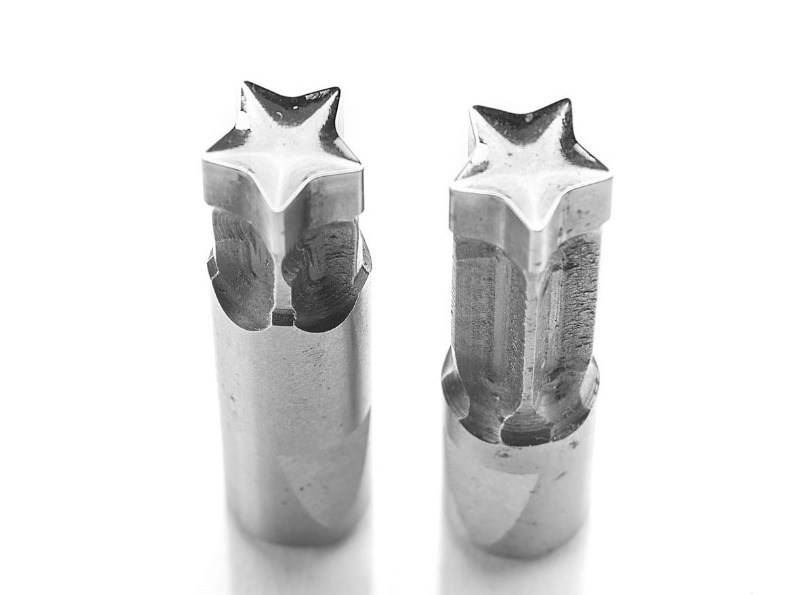Tooling Designs – Different Mixes Need Different Punches
It has always been challenging to market a tablet in the industry. Time, capital, research and development are all very important to the process, but one of the most difficult phases is the actual production of the tablet. There are a number of factors that must be considered during production, including tablet quality and downtime of tablet equipment, which, if not addressed, can cause delays in shipping the product. There are several steps that can be taken before manufacturing even begins to minimize the likelihood of encountering such issues.
The tooling and tablet design can make or break any tablet manufacturing process. With that said, how can the right equipment be distinguished? And is it really possible to resolve the problems before manufacturing starts? Maintaining excellent communication between team members and concerned departments and ensuring that everybody involved has an in-depth knowledge of the product can help enormously in the prevention of both of these issues.
Before handling the tablet design for manufacturing, the research and development department must have an intimate knowledge of the formulation’s entire make-up, from the physical structure to chemical specifications. There should be communication between team members from beginning to end; from granulation of the formulation to preparation for compression, right up to the final product. The tablet compression team should be involved with the entire process since they often are responsible for the success of the tablet’s compression as well as launching it into the market.
Other key factors that may affect the success of the tablet manufacturing process include the powder’s characteristics, tablet design, and the ambient relative humidity. Experts can analyze these factors and help to prevent issues that are common in the tablet manufacturing industry, such as sticking and picking. As well as consulting with the whole team, it is also essential that the process be discussed with an experienced tooling vendor.
As the formulation and the compression tooling work together to generate the product, it is integral that communication is maintained with the tooling vendor. The vendor will have an in-depth knowledge of the equipment and will be able to recommend the best products to complement the powder formulation. Powders that have abrasive properties, for example, may require materials that have resistant properties instead of standard material types.
Common Processing Routes
When deciding which way to process, the required properties of the tablet must be considered. There are three different ways to prepare powder formulations for compression:

Sign Up to Our Newsletter
Direct compression
Direct compression is used when the ingredients can be blended and a compressed tablet meets the dissolution and uniformity requirements. Direct compression is affordable and less costly than other options because it easily blends all the excipients, lubricants and fillers together. It is important to ensure that proper blending is undertaken to maintain uniformity of the dosage before compression.
Granulation is the process whereby all particles are collected to form granules. The particles are either compacted or formed by adding a binding agent.
Dry granulation
Dry granulation is used when the formulation is sensitive to heat or moisture and so is not amenable to direct compression blending. To form the particles, machines like chilsonators and roller compactors are used. Once compact, the tablet density increases and granules are then formed from the small particles. The pellets are milled to the right particle size for distribution and then put through the compression process on a tablet press.

Wet granulation
Wet granulation is used when the API’s physical properties preclude the use of dry granulation. Here, the APIs and excipients are blended together with the addition of liquid via the spraying method, which helps the particles to stick together. To enhance granule growth, binders may also be added to the mixture. The granules are left to dry out before undergoing milling and blending to attain the right formulation.
Though the process of wet granulation can be more expensive and time consuming, it is the only option that meets the specification of some drugs. The process can cause downtime when there is retention of latent moisture in the finished powder. Common issues include laminating, capping, picking, and sticking; these can all be avoided with a little pre-thought on the manufacturers part.
If the root cause is undetermined and any problems during the developmental stage have been addressed, compression tooling equipment can be to blame for these problems. There is a wide range of tablet design and tooling options available for tablet manufacturers today and as such, how the granulation method and powder preparation can influence and shape tablet designs and tooling equipment should be taken into consideration.
The tooling equipment should be engineered and developed based on the product that is to be compressed; however, many still use standard tablet configuration, even if the formulation is different and unique. Ideally, the compression tools and tablet designs should be configured for individual products and formulations. Nevertheless, to reduce costs, many companies are now using direct compression blends; this can cause problems, particularly if potential issues are not addressed at the beginning of the process.
Some formulations are easy to compress with either a deep or shallow cup tool. This is however not always the case – some formulations can be difficult to compress when using a compound cup but can be compressed easily when using a standard cup.
Similarly issues can occur when using the dry granulation method. As the powders are compressed, excess fines or dust may recirculate around the die table, which can affect the next tablet to be compressed. This is when the dust attaches itself to the next tablet and subsequently causes variability in the tablet’s properties. Aside from compacting, the dust may also migrate to other areas of the tooling equipment, which can cause problems in the tableting process. The dust material can cause premature tip wear, tip binding, heat generation, die bore wear, and discoloration of the tablet, as well as capping and laminating problems.
The shifted particles can cause contamination of the machine’s components and may compromise the lubricity of the lower punch barrel and head. This can result in premature wear of the press components and cause tool binding and downtime. Even if the tablet press works normally, the particles can make cleaning harder, meaning that more time is required for preparation of the equipment.
Although excess dust can be addressed before production begins, should it become necessary, a formulation designed to reduce effects on the compression process can also be used. This is why it is important to involve the development team throughout the process. If the formulation design causes problems, the decision might also be made to modify the tablet to ensure compatibility with the tooling design.
The team may also suggest changes to the compression equipment, such as narrowing the tip width. Although a small change, a narrow tip is an excellent option to consider, especially for dry blends, because it can reduce problems brought about by the fine dust particles during the dry granulation process. The dust can stick to the die wall and a narrower tip with a deeper relief can help remove the dust from the die to prevent any build-up.
The build-up of dust particles in the die bore coupled with the repeated motion can cause friction, which can lead to heat and in turn, cause problems for heat sensitive formulations. A deeper tip would not only remove the excess particles but also reduce the friction. This is because a narrower tip width reduces the contact between the tip and the die bore.
Tablet manufacturers should be aware that a great range of tooling options are available and the right choice could provide longer lasting dies and punches. To prevent the tooling equipment from being an afterthought communication with the team should be encouraged throughout the process. This can ensure that the right tooling equipment is used and in the long run, can result in savings for the company. Knowing the formulation characteristics also means that tablet manufacturers can consult with their tooling vendor with regards to design and materials, helping them to make the best choices from the start.
Standard steel tools are used for their overall balance and ability to absorb shock; however, these steels may not be suitable for some punches and dies (e.g. when there is a high chrome and carbon content.) The D3 steel shows great resistance but has poor load and a low compression level; as such, it can be used for die but is a poor option for punches.
Steels with high chromium content can be great options for products that are sticky or can cause corrosion. Steels that have high Rockwell hardness are also good options, especially when abrasion is the main concern. There are different tooling options that can be utilized to prevent the lower tips to bend when manufacturing small tablets. The punches can also be designed with an extended head flat to increase the dwell time for products that are more difficult to compress.
Simply changing the finish on the punch face can make a great difference on how a specific formulation runs in the press. The tips can be coated with chrome to improve resistance; different coatings are available to solve different problems. That said, adding coatings should not be the go-to solution for problems; it is important to choose the right steel type and tooling configuration to provide a longer-term benefit. Some coatings are expensive and may cause problems later on.
These are just some of the solutions available to tablet manufacturers. Tooling can be designed depending on the specification of the formulation properties. Even at the start of the design stage, pre-picking along with cup modification and configuration can prevent problems such as picking, capping, lamination and sticking. Some formulations that have high compression force may also benefit from having a narrower cup depth or additional tablet land.
Choosing the right delivery, having clear communication and talking with a tooling vendor throughout the developmental process are the best steps to take to ensure successful tablet production. These steps should ensure that once the granulation reaches the compression process, the proper tooling is available.
Preparation is important, if only because it brings cost savings to the company. Not only will the company be able to manufacture tablets efficiently, but there will also be less premature wear to tooling equipment. Some reputable tooling vendors also collaborate with research organizations to provide insights on powder properties and find the best solutions for the future.









